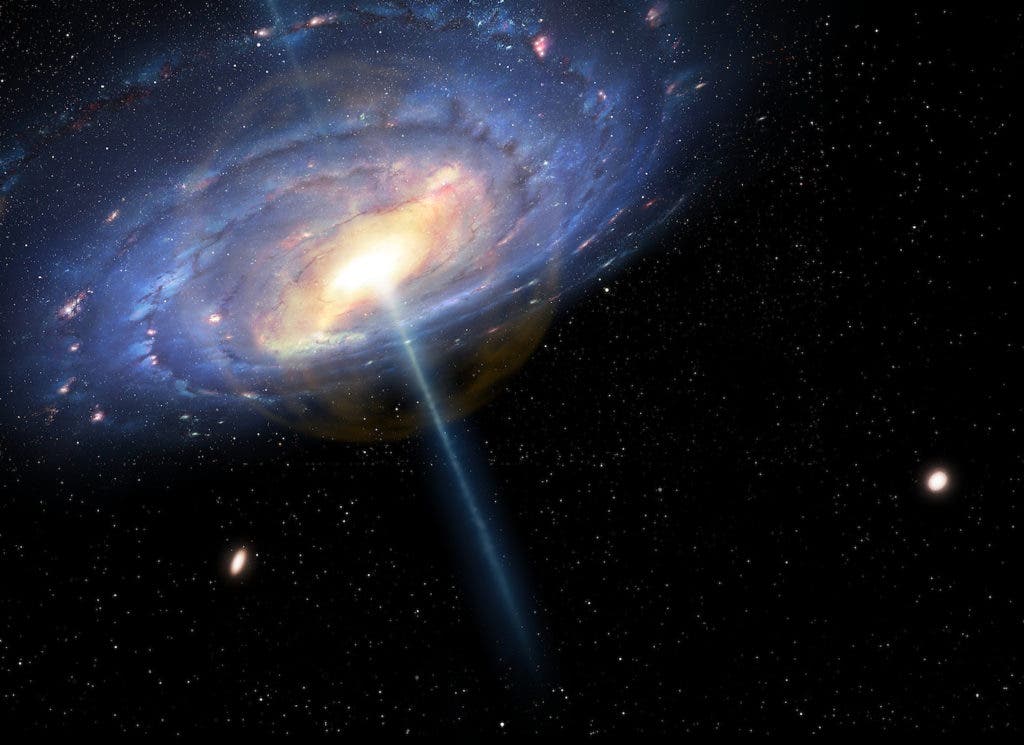The supermassive black hole that lies at the center of the Milky Way may be dormant now, but research suggests that this has not always been the case.

Image credits Mark A. Garlick / CfA.
The center of our galaxy was once an incredibly lively and spectacular place, with a super-energetic quasar feeding matter into a black hole formed at the central point of the Milky Way. Some 6 million years ago, however, this quasar exploded and the black hole went into hibernation. This event was so violent and released so much energy that its shock waves can still be picked up today, say scientists from the Harvard-Smithsonian Center for Astrophysics (CfA) in Cambridge, Massachusetts.
The team made this discovery while trying to find an explanation for a quantity of matter that seems to be missing from the Milky Way. You see, estimates put the mass of out galaxy at between 1 to 2 trillion times that of our Sun, the CfA team explains. Roughly five-sixths of this mass is dark matter, while the remaining mass consists of normal matter — gas, dust, and stars. But even so, when we add up all the matter we can see, we still come up short.
Between 85 billion and 235 billion solar masses’ worth of material appears to be missing, the researchers write in their paper.
“We played a cosmic game of hide-and-seek, and we asked ourselves, ‘Where could the missing mass be hiding?'” Fabrizio Nicastro, lead author of the new study and a CfA research associate, said in a statement.
“We analyzed archival X-ray observations from the [European Space Agency’s] XMM-Newton spacecraft and found that the missing mass is in the form of a million-degree gaseous fog permeating our galaxy. That fog absorbs X-rays from more distant background sources.”
By crunching these X-ray absorption values through computer models, the team calculated how much matter it added up to originally and how it was distributed. But surprisingly, they realized their observations couldn’t be explained by a smooth, uniform distribution of gas — instead, it seems to have been blown away by the exploding quasar in the middle of the galaxy. They believe this event took place 6 million years ago and that the shock waves it created formed a gasless “bubble” around the explosion. Deprived of matter, the galactic core became inactive.
It would take a monumental amount of energy to create this bubble, and the team believes that it likely came from gas falling into the black hole. As it was attracted by the black hole, part of the gas was absorbed and the rest was pumped outwards at speeds in excess off 3.2 million km/h (2 million mph.)
The material that flowed toward the black hole would have accumulated to create new stars. Researchers found evidence of this in the presence of 6-million-year-old stars near the galactic center that are made of the same material, they report.
“The different lines of evidence all tie together very well,” said co-author of the study and a CfA researcher Martin Elvis.
“This active phase lasted for 4 [million] to 8 million years, which is reasonable for a quasar.”
The new study also shows that this gas, heated up to millions of degrees, adds up to 130 billion solar masses. This would explain why we haven’t seen it yet — it’s just too hot.
While this isn’t the complete answer to the mystery of our galaxy’s missing mass, it gives us a better idea of the materials and processes that formed the Milky Way.
The full paper, titled “A distant echo of Milky Way central activity closes the galaxy’s baryon census” has been published in the journal Astrophysical Journal Letters.


